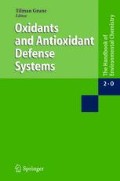Abstract
Glutathione is the most abundant non-protein thiol in cells. It is a tripeptide with two important structural features: the thiol group and the gamma-glutamyl peptide bond between glutamate and cysteine. It is a major antioxidant, able to reduce peroxides (due to its action as substrate of glutathione peroxidases). As a result it is oxidised to the disulphide form (GSSG), which in turn is reduced back to GSH by glutathione reductase. Thus glutathione is a major player in maintaining physiological redox status in cells.
Some of the functions of glutathione depend on the presence of the gamma-glutamyl bond, for instance its role in the regulation of amino acid transport. But the majority of the functions of glutathione are related to its role in redox regulation in cells and in detoxification of xenobiotics.
Some areas of research of special interest on this molecule are glutathionylation of proteins, the cellular compartmentation and the role of this interesting molecule in disease.
Preview
Unable to display preview. Download preview PDF.
Author information
Authors and Affiliations
Corresponding author
Editor information
Rights and permissions
About this chapter
Cite this chapter
Sastre, J., Pallardo, F.V., Viña, J. Glutathione. In: Grune, T. (eds) Reactions, Processes. The Handbook of Environmental Chemistry, vol 2O. Springer, Berlin, Heidelberg. https://doi.org/10.1007/b101148
Download citation
DOI: https://doi.org/10.1007/b101148
Published:
Publisher Name: Springer, Berlin, Heidelberg
Print ISBN: 978-3-540-22423-5
Online ISBN: 978-3-540-31916-0
eBook Packages: Earth and Environmental ScienceEarth and Environmental Science (R0)

